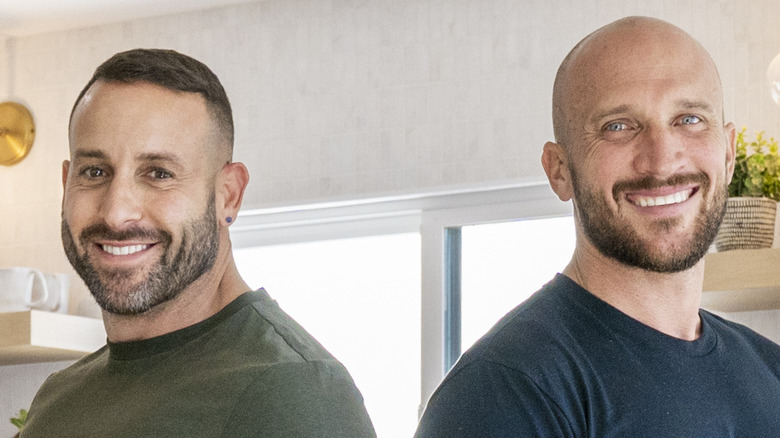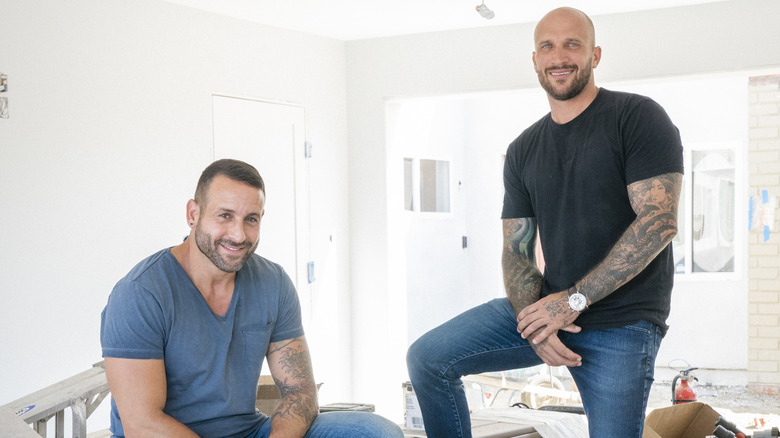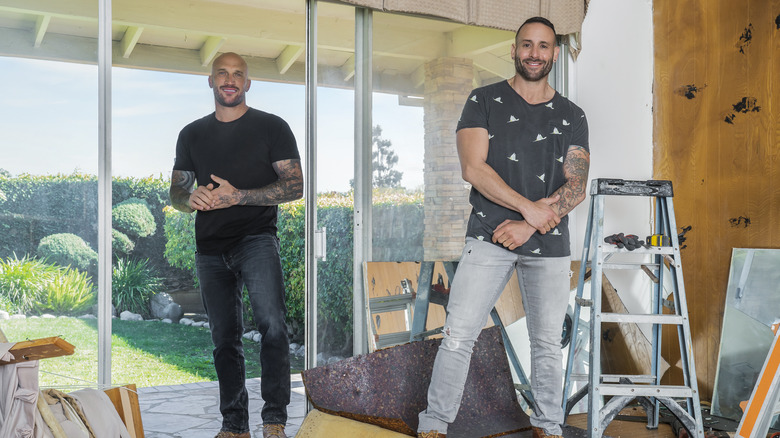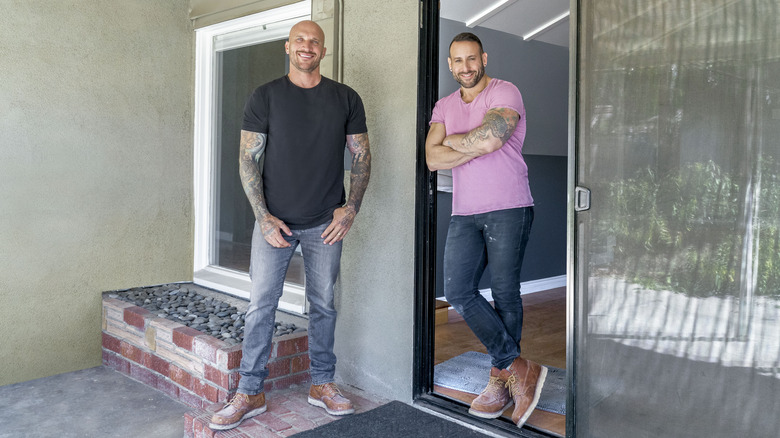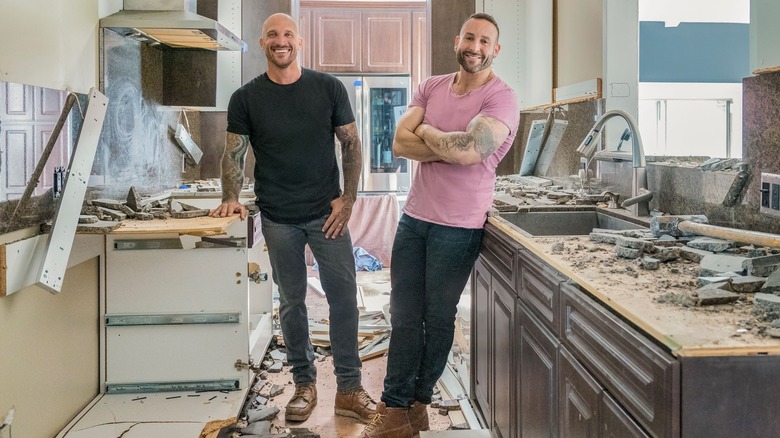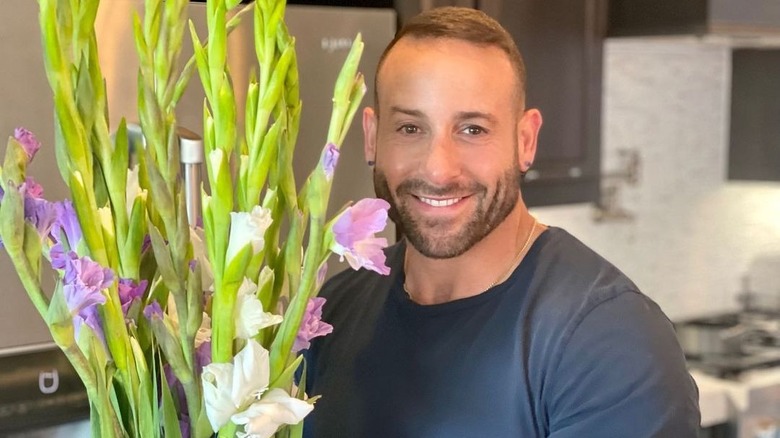HGTV's Carmine Sabatella & Mike Pyle Share Home Reno Tips - Exclusive Interview
For many homeowners, the toughest part of any renovation project is deciding what they want — or more precisely, deciding what they most want to do with the funds and resources they have available. It's easy to say "yes" to a long list of cool upgrades if you have an unlimited budget and unlimited access to top-shelf materials — but almost nobody in the real world does. So if you're an ordinary mortal with a fixed budget, how do you decide what really needs changing — and what can be left alone?
This is where a skilled design team can help. In their HGTV show "Inside Out," interior designer Carmine Sabatella and landscape designer Mike Pyle help homeowners decide how to get the most value out of fixed renovation budgets. But first, however, each competes to get a bigger slice of the pie: Sabatella proposes plans for extensive interior renovations, while Pyle advocates for making outdoors areas a bigger focal point. But whatever the homeowner decides, Sabatella and Pyle work side-by-side to make it happen. In this exclusive interview, they open up about the challenges of renovation, common misconceptions about upgrading your home, and smart ways to prioritize your budget when remodeling.
Carmine Sabatella and Mike Pyle didn't know each other well before Inside Out
First of all, could you tell me a bit about your professional partnership? When and why did you start to work together?
Carmine Sabatella: Mike you want to answer that?
Mike Pyle: Yeah, sure. In 2017, our producer DM'd me on Instagram, and asked if I wanted to have a TV show. My initial answer was no, and then I thought about it a little bit longer. I had met Carmine previously on a job site, probably about six months prior. My associates recommended that he might be a good fit and complement me and be a good person for the show. Before you know it, we were in front of a camera shooting a sizzle reel. That was our first time we had ever met one another, or ever been in front of one another, and we hit it off — and here we are today.
Carmine Sabatella: Yup.
What was your inspiration for "Inside Out"?
Mike Pyle: Go ahead, Carmine.
Carmine Sabatella: Well, an easy inspiration for "Inside Out" for us was we wanted to build and deliver a show that's a little bit different than what would be anticipated on HGTV. The Discovery Network, as you know, absorbed HGTV a few years ago, so I think they were kind of ready to change the platform, and we became the guinea pigs for that new model. Prior to "Inside Out" — and maybe one or two shows that we watched from the same time — what we did was kind of ... move up the format where the designers would come in, the clients would leave, they would redecorate everything, recreate everything, and when they came back they'd look surprised. "Here's your new house."
[We wanted] to do something different, where we were working with the clients every step of the way; they were in the trenches with us. They were making decisions with us, the good, the bad, and the ugly. And that kind of was what really became the premise of the show, and the format that we wanted to deliver.
There's more to exterior design than most people think
How do you find the homeowners that you worked with on this show?
Mike Pyle: Go ahead, Carmine.
Carmine Sabatella: No, go ahead, man.
Mike Pyle: It's a collaboration of people that we are acquaintances of, or a friend of a friend; there [were] some people that production picked as well. It was kind of a mix of people for Season 1, and for Season 2. They would send in their auditions to production, and then we would obviously give referrals as well for people that we knew, whether it was somebody that we knew very casually, or someone that we knew that was a friend of ours. We all kind of threw the hat into the basket along with all of the clients that would send their videos in to production. Then we went from there.
What are some common misconceptions that you hear from homeowners about renovation?
Carmine Sabatella: I can start with that, from the inside. Number one is budget. Everyone seems to have a different concept of what pricing is going to be like. I think a lot of that also has to do with the renovation shows ... that aren't all that realistic on a lot of different networks. I think that the biggest challenge is getting them to understand how that budget is distributed, and what the true cost of things are. I think also, just honing them in because a lot of clients will go on Pinterest, or they go on Insta, building all of these of creative boards, and ideas and concepts. They have a million ideas that they want to cram into one thing. Obviously, you can't do that. It'll look like a fun zone. We have to kind of reel them [in], and give them direction.
Mike Pyle: Yeah, I think for the land use side of it, you've just got to admit [that] people think that "It's outside. It's just dirt, plants, and irrigation, and call it a day. And we're good." But there's a lot of really creative spaces. Different materials. There's decking, or concrete, and the water features. The thing will add up real quick; before you know it, you're spending more money on the outside than the inside. It's not worth it depending on the remodel. I just did a remodel, and it literally cost me double what I anticipated. Things are just very expensive right now.
Communicating their vision to homeowners is a critical part of their job
Mike, I wanted to follow up on that. Another question for you is that people often overlook or under-use their outdoor spaces. How do you convince them of their value?
Mike Pyle: I've been doing this for about the better part of my life, over 20 years now. Just creating moments outside is something that I know a lot of people can't see. But, once I get on site, once I walk through something, and create an interior courtyard, or create the back space for their home, and create all these moments in the yard — once I walk through with them, they can kind of see it. It's inspiring within themselves. It just takes a professional to really walk through it, create a plan, and then they could really start to envision it, and see where that dollar can go, and to do that is quick work for them.
For both of you, what has been your most challenging project on this show?
Carmine Sabatella: Yeah. I think for me, the biggest challenge yet is for clients to understand my madness when I bring them [the] concept coming in, getting them to really grasp the direction that I'm going in. When I bring in samples — for instance, if I'm showing them paints, plushes, pouring material, tile selections — all of that together is a little overwhelming. And when you see it all on a small scale, it looks like there's a lot going on. But what you have to think about is you're spreading that on top of an entire interior of a home. Some of these homes are big. So to me it's really that's the biggest challenge, on the show for me, is to get the clients to understand the direction that I'm going in, and have them trust it, trust the process.
Another challenge is helping homeowners find their own vision
Is there a specific incident or project from one of your episodes, and you'd like to share?
Mike Pyle: Have you seen the first episode yet? That was a challenging one for me personally. It wasn't horribly challenging, but just really getting the client to really understand — they definitely kind of knew what they wanted, but it definitely took a little more. They're amazing people, but it just really took a little more effort for them to really see the vision. But once they did, it was a sweet vision.
Carmine Sabatella: Right.
Mike Pyle: I think Carmine had kind of a similar experience with that one too.
Carmine Sabatella: I think I would have to turn that to the Millers too, because they just had so much that they wanted to do, and kind of really reeling them in. And getting them to understand that there was so much that they wanted to do in the new space, between the kitchen, the dining room, and the family room. I just had to kind of reel them in, and go, "Okay. Let's focus on the big concept, and then build from there because there's just too much going on."
Here's the interior design trend Carmine Sabatella is seeing now
That leads into the next question I was going to ask you, Carmine. What trends are you seeing now, in terms of room layout? What kinds of changes are people asking for?
Carmine Sabatella: For the inside, I think, what I see trending out now is all of these crazy open wall concepts. Years ago, everybody wanted to open up everything, knock all the walls down, no more walls. In theory, that's great, especially when your children are little, or toddlers, that makes sense. But those children grow up like weeds, and we're not ready. All of the sudden they're pre-teens and teenagers, and that open-wall concept where everyone was sharing space isn't as appealing anymore. We're seeing that kind of trend out. I don't know if that's just a generational thing, but we're saying people going, "Okay. You know what? Friends who did that 10 years ago, and now they're miserable, and they're trying to fix it, so we don't want to do that now." You want to open up a little bit of the space, but it's not like, "Tear down all the walls, and open up, and make it a huge open-wall concept."
Carmine Sabatella shares his advice for prioritizing renovation budgets
That's interesting! Can either of you share any recommendations for connecting interior and exterior spaces effectively?
Mike Pyle: Yeah. Bifold doors. I just did my house. I did a bifold door on the front side of my house to create length and a courtyard, and on the back side, I did the same to kind of connect my backyard once you open up the bifold doors. They are pricey, but personally, I would think that this is at the top of my list for any remodel, if you can fit in a bifold door to connect the spaces immediately. It might hurt a little bit to put some money on it, but once you see those installed, it's worth every penny.
Finally, my last question is what advice would you share about prioritizing your renovation budget? What factors should homeowners consider or not consider?
Carmine Sabatella: For the interior, [the] most important [thing] to pick is the focal point. For instance, when you're doing a kitchen remodel. We would all like [to say] "Look, I have $100,000 to just build their dream kitchen." Right? That isn't the case for most of us. I would tell the client, "What do you want to pop? What is most important for you to stand out? Is it the backsplash? Or is it the countertop? Or is it the kitchen cabinets?" Once you pick the focal point, then you spend the money, splurge a little bit on that feature, and then you build from there and it kind of trickles down. I think that's for any room. That can be for the bathroom, that can be for the primary bedroom. Right? You pick one item that you really, really want to focus on. Your guests could come in, and really admire, and see, and then you build down from there.
Season 2 of "Inside Out" premieres Monday, August 1 at 8 p.m. ET/PT on HGTV.
